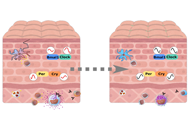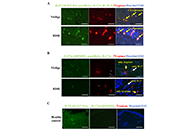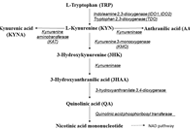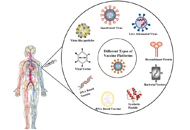Aim:
Chronic inflammation is closely associated with tryptophan (TRP)-kynurenine (KYN) metabolic pathway. However, TRP-KYN pathway has not been fully elucidated in psoriasis, a systemic inflammator
[...] Read more.
Aim:
Chronic inflammation is closely associated with tryptophan (TRP)-kynurenine (KYN) metabolic pathway. However, TRP-KYN pathway has not been fully elucidated in psoriasis, a systemic inflammatory disease with skin lesions and extracutaneous manifestations. Herein, we studied comprehensively serum profiles of TRP-KYN pathway metabolites in psoriatic patients (PSOs) to clarify the involvement of this pathway in the pathophysiology of psoriasis and to evaluate serum biomarkers reflecting systemic inflammation in PSOs.
Methods:
The concentrations of main TRP metabolites, TRP, KYN, 3-hydroxykynurenine (3HK), kynurenic acid (KYNA), 3-hydroxyanthranilic acid (3HAA), and anthranilic acid (AA), were determined by high-performance liquid chromatography in the sera from 65 PSOs and 35 healthy controls (HCs). The levels of these metabolites and the ratios of metabolites were compared between these subjects. The correlations between these values and the psoriasis area severity index (PASI) scores were analyzed. Skin samples from PSOs and HCs were subjected to immunohistochemical staining for kynureninase, catabolic enzyme from KYN or 3HK to downstream. Cytokine concentrations were comprehensively measured in the same samples and the correlations between the cytokine levels and TRP-KYN pathway metabolite levels were examined.
Results:
Serum TRP, KYN, and KYNA concentrations were lower and the 3HAA concentrations were higher in PSOs than in HCs. The ratios of 3HK/KYN, 3HAA/3HK, and 3HK/AA were higher in PSOs than in HCs. The AA levels and the ratio of AA/KYN were weakly positively correlated, and TRP, KYNA, and 3HK levels and the ratios of KYNA/KYN and 3HAA/AA were weakly negatively correlated with the PASI scores. The AA, KYN, and KYNA levels were positively correlated with the interferon gamma-induced protein 10 (IP-10) concentrations. Kynureninase expression was enhanced in the epidermis, both involved and uninvolved skin.
Conclusions:
Serum profiles of TRP-KYN pathway metabolites differed between PSOs and HCs. TRP-KYN pathway-associated processes, including kynureninase activation, may be involved in the pathogenesis of psoriasis, and thus serve as targets for psoriasis therapy.
Mariko Seishima ... Kuniaki Saito
Aim:
Chronic inflammation is closely associated with tryptophan (TRP)-kynurenine (KYN) metabolic pathway. However, TRP-KYN pathway has not been fully elucidated in psoriasis, a systemic inflammatory disease with skin lesions and extracutaneous manifestations. Herein, we studied comprehensively serum profiles of TRP-KYN pathway metabolites in psoriatic patients (PSOs) to clarify the involvement of this pathway in the pathophysiology of psoriasis and to evaluate serum biomarkers reflecting systemic inflammation in PSOs.
Methods:
The concentrations of main TRP metabolites, TRP, KYN, 3-hydroxykynurenine (3HK), kynurenic acid (KYNA), 3-hydroxyanthranilic acid (3HAA), and anthranilic acid (AA), were determined by high-performance liquid chromatography in the sera from 65 PSOs and 35 healthy controls (HCs). The levels of these metabolites and the ratios of metabolites were compared between these subjects. The correlations between these values and the psoriasis area severity index (PASI) scores were analyzed. Skin samples from PSOs and HCs were subjected to immunohistochemical staining for kynureninase, catabolic enzyme from KYN or 3HK to downstream. Cytokine concentrations were comprehensively measured in the same samples and the correlations between the cytokine levels and TRP-KYN pathway metabolite levels were examined.
Results:
Serum TRP, KYN, and KYNA concentrations were lower and the 3HAA concentrations were higher in PSOs than in HCs. The ratios of 3HK/KYN, 3HAA/3HK, and 3HK/AA were higher in PSOs than in HCs. The AA levels and the ratio of AA/KYN were weakly positively correlated, and TRP, KYNA, and 3HK levels and the ratios of KYNA/KYN and 3HAA/AA were weakly negatively correlated with the PASI scores. The AA, KYN, and KYNA levels were positively correlated with the interferon gamma-induced protein 10 (IP-10) concentrations. Kynureninase expression was enhanced in the epidermis, both involved and uninvolved skin.
Conclusions:
Serum profiles of TRP-KYN pathway metabolites differed between PSOs and HCs. TRP-KYN pathway-associated processes, including kynureninase activation, may be involved in the pathogenesis of psoriasis, and thus serve as targets for psoriasis therapy.
 Viral vector-based vaccines against SARS-CoV-2Open AccessReviewViral vectors have been frequently applied for vaccine development. It has also been the case for vaccines against severe acute respiratory syndrome coronavirus 2 (SARS-CoV-2) to tackle the coronavi [...] Read more.Kenneth LundstromPublished: October 31, 2021 Explor Immunol. 2021;1:295–308
Viral vector-based vaccines against SARS-CoV-2Open AccessReviewViral vectors have been frequently applied for vaccine development. It has also been the case for vaccines against severe acute respiratory syndrome coronavirus 2 (SARS-CoV-2) to tackle the coronavi [...] Read more.Kenneth LundstromPublished: October 31, 2021 Explor Immunol. 2021;1:295–308 Skin and immune cells crosstalk via circadian regulationsOpen AccessReviewBoth innate and adaptive immune cells exist in the skin, predominantly in the dermis layer. Recent studies have focused on how and which circadian rhythms contribute to maintain good health. Over re [...] Read more.Kanami OriharaPublished: October 31, 2021 Explor Immunol. 2021;1:285–294
Skin and immune cells crosstalk via circadian regulationsOpen AccessReviewBoth innate and adaptive immune cells exist in the skin, predominantly in the dermis layer. Recent studies have focused on how and which circadian rhythms contribute to maintain good health. Over re [...] Read more.Kanami OriharaPublished: October 31, 2021 Explor Immunol. 2021;1:285–294 The two faces of mast cells in vitiligo pathogenesisOpen AccessOriginal ArticleAim: Previously, we reported increased number of T helper 17 (Th17) cells in vitiligo. However, in our recent study, tryptase and interleukin (IL)17 double positive cells which identified by polycl [...] Read more.Ichiro Katayama ... Mari Wataya-KanedaPublished: October 31, 2021 Explor Immunol. 2021;1:269–284
The two faces of mast cells in vitiligo pathogenesisOpen AccessOriginal ArticleAim: Previously, we reported increased number of T helper 17 (Th17) cells in vitiligo. However, in our recent study, tryptase and interleukin (IL)17 double positive cells which identified by polycl [...] Read more.Ichiro Katayama ... Mari Wataya-KanedaPublished: October 31, 2021 Explor Immunol. 2021;1:269–284 Serum profiles of tryptophan-kynurenine pathway metabolites in psoriasisOpen AccessOriginal ArticleAim: Chronic inflammation is closely associated with tryptophan (TRP)-kynurenine (KYN) metabolic pathway. However, TRP-KYN pathway has not been fully elucidated in psoriasis, a systemic inflammator [...] Read more.Mariko Seishima ... Kuniaki SaitoPublished: October 31, 2021 Explor Immunol. 2021;1:258–268
Serum profiles of tryptophan-kynurenine pathway metabolites in psoriasisOpen AccessOriginal ArticleAim: Chronic inflammation is closely associated with tryptophan (TRP)-kynurenine (KYN) metabolic pathway. However, TRP-KYN pathway has not been fully elucidated in psoriasis, a systemic inflammator [...] Read more.Mariko Seishima ... Kuniaki SaitoPublished: October 31, 2021 Explor Immunol. 2021;1:258–268 Immune responses induced by different vaccine platforms against coronavirus disease-19Open AccessReviewThere have been significant developments in the design of nanostructured scaffolds for eliciting robust immune responses named vaccine. The technique is to produce strong immune responses is to mani [...] Read more.Eknath D. Ahire, Sanjay J. KshirsagarPublished: October 31, 2021 Explor Immunol. 2021;1:243–257
Immune responses induced by different vaccine platforms against coronavirus disease-19Open AccessReviewThere have been significant developments in the design of nanostructured scaffolds for eliciting robust immune responses named vaccine. The technique is to produce strong immune responses is to mani [...] Read more.Eknath D. Ahire, Sanjay J. KshirsagarPublished: October 31, 2021 Explor Immunol. 2021;1:243–257